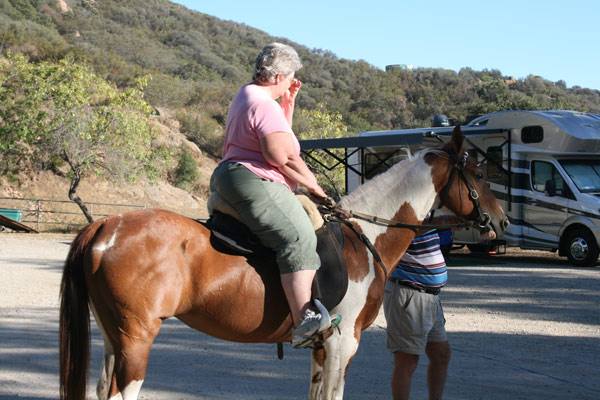Can Overweight People Ride Horses?

I must say that in starting this topic, I am not looking to embarrass anyone, nor to make criticisms or jokes about their physical condition.
Having said that, it is not about shaming, it is a matter of education and how much weight an average horse can carry. The person has to consider the weight ratio that the horse can comfortably carry.
People with riding businesses have a weight limit of approximately 230 lbs (104 kg). That said, this limit exists because horses weigh between 800-1,600 lbs (363-725 kg), larger horses carry heavier clients, but exceeding the weight limit means the person is risking their own safety by getting on the horse.
Being so big you can’t get your leg up that high even with a step or with the help of others. Riding business owners, don’t want to spend thousands of dollars on chiropractors for horses because someone weighs almost 300 pounds (136 kg) and they popped their horses back.
If you are a little overweight, you may find it difficult to ride a horse. Not every horse can carry a lot of weight. The ideal human weight for a horse is 200 lbs (91 kg) and under but there are exceptions.
Just continue reading to find out about those exceptions.
Is there a weight limit for horse riding?
Yes, there are certain limitations on the weight of a person in relation to the weight and size of the horse itself, If the horse is not that light, then it should have no problem carrying people who weigh under 200 pounds. The ideal human weight for a horse is 20% of the horse’s actual weight.
Horses generally weigh between 840 and 2000 pounds and you just need to do the math to make sure your weight will not be a burden to the horse.
However, with that said, there are lighter horses that have been able to carry extremely heavy people long distances without getting stressed or overworked.
Whether they can carry you or not depends on the horse, not just its size. When it comes to riding stables, most have rules about how heavy you can weigh.
The majority of stables do not let people weighing over 250 pounds ride their horses.
There are a couple that goes over that 250-pound mark but they are the exception, not the rule. Draft horses should be able to carry heavier weights but that is up to the stable owner to decide.
Some bigger people feel more comfortable on a draft horse. That feeling is due more to how they look than anything else. Keep in mind that a horse has often carried its owner and dead game back from a hunting trip with no issues. So an overweight person should be able to ride a good horse without a problem.
Which horse breed is better at supporting overweight people?
Depending on the severity of the excess weight, the most sensible thing to do is to work with the horse from the ground and, for the good of the animal, refrain from riding.
However, if we are only talking about slight overweight, it is clear that there are some breeds that can handle the extra stress better than others.
However, the amount of weight a horse can carry depends on several factors.
Just because a horse has a stocky build, such as a draft horse, does not mean that it is capable of carrying weight.
It also always depends on the animal’s level of training as to how much weight it can bear without damage.
Is there such a thing as a weight carrier among horses?
No, there are no so-called “weight carriers” among horses.
Of course, a Haflinger can carry more weight than a mini Shetland pony, but even the most robust horse (regardless of breed) should not be expected to weigh more than 80 kg – after all, the rider’s weight also includes clothing and a saddle, which is usually quite heavy.
It is often wrongly assumed that draft horses are particularly resilient due to their massive exterior, but in fact, the draft horse is one of the horses that can withstand the least stress.
Draft horses were originally not bred for riding, but for pulling, which is why the maximum rider weight was irrelevant.
The weight load factor of a horse
For a long time, the rule applied that the maximum weight of a rider could be 20% of the horse’s weight in order not to damage it in the long term.
In fact, however, nothing can be done with this rule, since there are also overweight and underweight horses, every breed has a different physique and not every horse is equally well muscled.
The tendons and ligaments must also be stable enough to be able to carry even light riders without damage.
The cannon bone load index is therefore more meaningful than the 20% rule.
You can calculate this by multiplying the cannon bone circumference in centimeters by 100 and dividing the result by the horse’s body weight in kilograms.
The higher the value, the more resilient your horse is.
| race | RI |
|---|---|
| Minishetland Pony | 9.5 |
| Riding Pony | 4.5 |
| Icelandic horse | 4.7 |
| Arabian thoroughbred | 4.1 |
| Kabarda | 4.2 |
| Wuerttemberg | 3.4 |
| Bavarian Warmblood | 3.6 |
| Hanoverian | 3.7 |
| Draft horse | 3.0 |
| Trakehner | 3.1 |
The RI of a Shetland pony, for example, is remarkably high with a value of 7.4 – especially when you consider that a Draft horse only has a value of 3.
This does not mean, however, that a Shetland horse can carry an 80 kg human in the long run compared to a draft horse, just that it is more resilient than other breeds in comparison to its height and weight.
How do you know that you are too heavy for your horse?
Pay attention to signals when riding, such as a straight back, a raised head, tightness and drive and other pain signals.
But even from the ground, you can often see whether the rider is too heavy for the horse.
This is how depressions or swellings usually form at the pressure points of the saddle, which can be clearly seen and felt when the saddle is removed from the horse.
In an advanced stage, changes occur in the spine, and wearer fatigue sets in.
If a horse is loaded with too much weight for a prolonged period of time, in the worst case a collapse occurs, which causes great pain to the horse and makes it impossible to ride forever.
However, insufficient musculature can also cause the horse to be in pain and unable to carry weight.
How to mount a horse if you are overweight?
This is more of a problem when you are a short overweight person and not just an overweight one. The stirrups can be a little high and many overweight people cannot lift their left leg high enough to get their foot into that stirrup.
They have to rely on a little creativity to mount a horse properly. Some of the suggestions that have been used are as follows:
- Build a mounting block- there are different designs and sizes depending on your height that can be built. The key would be to make the mounting block sturdy enough to hold your weight
- Picnic table- some people have had to resort to this option. When they are roughly 5’ 1” or shorter, a mounting block may not be tall enough for them
- 5-gallon buckets- when a mounting block or picnic table is not handy, this little item will do for many people.
Exercises to help you mount a horse
If you are not sure you can mount a horse properly, then the following exercises should get your body ready for that awkward positioning you need to get up on a horse and into the saddle
#1. Lie down on your back, keeping your legs straight. When ready, lift one leg till your knee touches your chest. Clasp the knee with your hands and push your back against the ground.
#2. Take a sitting position with one leg tucked into your groin and the other leg kept straight. Try to touch your toes on the leg that is straight. This should work your hamstring muscles.
#3. Take a sitting position again but keep both legs straight. Once ready try to touch your toes.
Each exercise should be held for 30 seconds.
Which horse can carry 100 kg?
Body weight of 100 kg is borderline for every horse, even a well-built and strong warmblood. Pay attention to the RI value when choosing the right breed.







